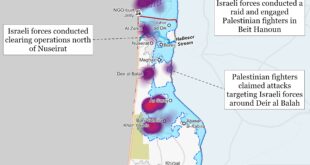The Islamic State is far from dead in Iraq and Syria. Despite losing its physical caliphate, the group maintained enough manpower and resources to continue waging an insurgency in both countries. And America’s partners and allies may not have adequate resources to finish off or contain the jihadist menace, as they “struggle” to hold territory liberated from the so-called caliphate’s grip.
These are just come of the conclusions found in a newly released inspector general report submitted to the US Congress and published online.
The US-led coalition, Combined Joint Task Force — Operation Inherent Resolve (CJTF-OIR), reports that “ISIS has been able to regroup and sustain operations in Iraq and Syria.”
One reason is that both the Iraqi Security Forces (ISF) and the Syrian Democratic Forces (SDF) “remain unable to sustain long-term operations, conduct multiple operations simultaneously, or hold territory that they have cleared of ISIS militants.”
The US military has had a small presence in Syria. On President Trump’s orders, the US withdrew some of those forces. The total number of American soldiers in Iraq and Syria isn’t clear, as those figures are contained in the classified portion of the inspector general’s report. But the partial withdrawal has already hurt the ability of the SDF to carry on the fight.
CJTF-OIR told the inspector general that the “drawdown decreased the amount of resources and support available to these Syrian partner forces at a time when they need additional reinforcing for counterinsurgency operations against ISIS.” Local forces “require much more training and equipment now than during the operations to defeat ISIS territorially,” CJTF-OIR said, explaining that stabilization operations and “ground-focused, human-based intelligence” are required “to confront ISIS insurgents effectively.”
The Islamic State’s three-part strategy
While the US has been pulling back, the Islamic State (ISIS) has moved forward with its plan to continue waging guerrilla warfare.
ISIS describes its “overarching strategy” for its “desert-based insurgency” as consisting of three parts: “sahara” (desert), “sahwat” (meaning awakenings — a derogatory reference to any Sunni Muslims who oppose the group), and “sawlat” (“hit-and-run operations”). This is according to CJTF-OIR, which submitted responses to the inspector general office’s questions.
Therefore, whereas the Islamic State had once proclaimed that is territorial caliphate was “remaining and expanding,” the group quickly returned to its insurgent roots after losing its turf, conducting guerrilla-style warfare against all of its enemies in the region.
ISIS in Iraq
According to the inspector general’s report, CJTF-OIR highlighted five “Sunni-majority provinces” in Iraq where the group captured ground in 2014 and now carries out regular attacks. Those northern and western provinces are: Anbar, Ninewa, Diyala, Kirkuk and Salah ad Din. In these same areas, the US-led military coalition warns, the Iraqi Security Forces (ISF) may not be able fully address the threat. The ISF “lacks sustainable military reach,” while ISIS “is still able to recruit in these areas using family and tribal connections.”
As is the case with other insurgents of the past and present, ISIS draws “popular support” to a large extent from “isolated and rural areas” outside of the security forces’ reach.
There are other holes in anti-ISIS campaign, too.
Peshmerga forces (security personnel in the Iraqi Kurdistan Region, or IKR) have played a key role in combating ISIS. But the DOD inspector general’s office points to “deep-seated internal Kurdish political divisions,” as well as the “Kurds’ continuing dispute with Iraq’s central government,” as serious obstacles in coordinating the fight against the jihadists. The dispute between the Kurds and Iraq’s government is “over a swath of disputed territory in northern Iraq rich in resources,” and has created “gaps” that allow “ISIS to regroup and plan attacks in the region.” Although some “progress” has been made in planning “joint security mechanisms,” cooperation between the Peshmerga and the ISF “remained limited.”
The pace of the ISF’s operations inside Iraq indicates that ISIS retains a significant force in the country.
“The ISF carried out nearly 1,000 operations against ISIS during the quarter, which resulted in the death or capture of more than 550 suspected ISIS insurgents,” the inspector general reports. Despite losing these 550 alleged insurgents, ISIS continues to operate throughout the aforementioned northern and western Iraqi provinces — regions where ISIS has long-established roots.
ISIS in Syria
As in Iraq, ISIS continues to pick its spots in Syria, seeking to undermine rival authorities. According to US Central Command (CENTCOM), ISIS’s “strategy in Syria is to create turmoil in territory that it has lost to challenge ruling authorities and assert its power.” In both countries, ISIS focuses “on assassinations and the burning of fields of crops” — operations that have been trumpeted in the group’s media.
ISIS “has activated resurgent cells in areas controlled by the SDF” and is using “these cells to conduct attacks in northeastern Syria and other areas of the MERV” (Middle Euphrates River Valley), CENTCOM is cited as saying. CENTCOM assesses that ISIS’s “strongest insurgent capabilities” are located in “Dayr az Zawr province, parts of Raqqah province, and Homs province near Palmyra.” In the Palmyra area, ISIS “frequently ambushe[s] pro-regime forces.”
Indeed, ISIS has long fought against Bashar al-Assad’s regime, and the two sides have continued to clash this year. During the preceding quarter, ISIS conducted multiple attacks against the Syrian regime and pro-regime forces.” The inspector general points to an attack on regime forces in the southern Dara’a province, the first such operation since August 2018. On April 20, ISIS attacks also killed “35 Syrian regime soldiers in Homs and Dayr az Zawr provinces.”
A looming potential issue is ISIS’s ability to reintegrate captured fighters, their family members and other displaced persons. ISIS is already eyeing al Hol, “a sprawling internally displaced persons (IDP) camp in northeastern Syria where thousands of ISIS family members now reside.” The group is “likely working to enlist new members from the camp’s large population of
IDPs.” For that reason, US authorities are trying to convince foreign authorities — whether they be Syrian “guarantors,” the Iraqi government, or the countries of origin for foreign fighters — to take responsibility for the detained persons, thereby “reducing ISIS’s recruiting pool.”
Meanwhile, ISIS is attempting to expand its “recruiting pool” in other ways, including by exploiting local grievances and discontent among the population in eastern Syria. This is an issue for America’s main anti-ISIS partner, the Syrian Democratic Forces (SDF). Citing CENTCOM, the inspector general’s office explains that “ethnic differences between the Kurdish-led SDF and the majority Arab residents of the MERV, including Dayr az Zawr province, provide ISIS with an opening to retain a residual foothold.” CENTCOM added that “ISIS could exploit other cultural differences, such as the differing gender roles between the ‘egalitarian SDF’ and ‘traditional Arab society’ to gain support.” ISIS also uses “resentment against the forced conscription of local young men into the SDF to foment popular discontent against the SDF.”
There are reports that the SDF, which is led by the Kurdistan Workers’ Party or PKK, a US-designated terrorist organization, is not handling this situation well. The inspector general’s report notes that SDF “commanders did not make significant concessions to tribal leaders who met with them to address these grievances in May, and the protests were developing into a popular uprising against Kurdish hegemony in Dayr az Zawr.”
Fuzzy distinction between ISIS “members” and “fighters”
As FDD’s Long War Journal has repeatedly cautioned in the past, it is likely that the US and its allies do not know the true number of ISIS fighters. Estimates vary widely.
CJTF-OIR assesses that ISIS still has between 14,000 and 18,000 “members,” including “fighters,” across Iraq and Syria. This includes “up to 3,000 foreigners,” according to the inspector general. But CJTF-OIR’s definitions are problematic. The US-led coalition draws a distinction between ISIS “members” who have “pledged allegiance to ISIS” and “fighters” who have “taken up arms to fight” for the group. Despite coming up with these two different categories, CJTF-OIR lacks the “granularity and resources” to “differentiate” between “ISIS members and fighters.” This draws into question the utility of its definitions and methodology.
Regardless, the Islamic State clearly has enough remaining forces to continue fighting its multiple adversaries across Iraq and Syria, as well as elsewhere.
 Eurasia Press & News
Eurasia Press & News



